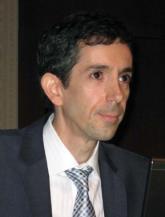News

Prolonged monitoring found best for detecting AF after cryptogenic stroke
Key clinical point: 24-hour Holter monitoring or conventional ECG monitoring is insufficient to detect AF in patients who had a cryptogenic stroke...
M. Alexander Otto, Family Practice News Digital Network
Key clinical point: Repeated Holter monitoring over 6 months catches more atrial fibrillation than one-time, poststroke monitoring.
Major finding: By 6 months, AF was detected in 27 patients (13.5 %) in the extended-monitoring group, versus 9 (4.5 %) in the control group (absolute difference, 9%; 95% confidence interval, 3.5%-14.6%; P = .002).
Data source: Randomized trial with 398 ischemic stroke patients.
Disclosures: The work was funded by Boehringer Ingelheim, maker of the oral anticoagulant dabigatran (Pradaxa). The presenter is a speaker and consultant for the company.
There is widespread belief among most stroke neurologists that when you have a stroke that looks embolic and you don’t have a source, you need to monitor for longer than we have done traditionally. The nuances are really how to do that. This is a great approach; it’s a lot easier than wearing a 30-day Holter monitor or having an implanted device, but we have to compare it to other approaches and see what the heart endpoints really are to know if it’s the best approach.
I think everybody in the stroke community appreciates that the more you monitor, the more you are likely to find AF. How long you should monitor, by what technique, and whether monitoring should be continuous or intermittent are unanswered questions. The other question is how much AF is significant. Is a 30-second run significant, or does it need to be minutes at a time? These questions need to be answered before there’s a wholesale buy-in for this kind of monitoring for every patient.
Dr. Kyra Becker is a professor in the departments of neurology and neurological surgery, and director of Vascular Neurology Services at the University of Washington’s Comprehensive Stroke Center in Seattle. She was not involved in the study.
AT THE INTERNATIONAL STROKE CONFERENCE
LOS ANGELES – Atrial fibrillation is three times more likely to be detected within 6 months of an ischemic stroke if, instead of the usual 24 or so hours of Holter ECG monitoring, patients are monitored for 10 days poststroke, and then again for 10 days at 3 and 6 months, according to German investigators.
“Enhanced and prolonged monitoring should be considered for all stroke patients to improve the detection of atrial fibrillation,” said investigator Dr. Rolf Wachter, a cardiologist at the University of Göttingen (Germany).
Patients in the trial had no history of atrial fibrillation (AF) and were at least 60 years old; 200 were randomized to the extended-monitoring protocol, and 198 to standard of care, which included a median of 24 hours of Holter monitoring. The median time from symptom onset to randomization was 3 days. All patients were enrolled by day 5.
The study wasn’t limited to cryptogenic strokes; although the first stroke may not have been related to atrial fibrillation, a recurrent stroke could be, so “our approach was to look for AF in all stroke patients irrespective of etiology,” Dr. Wachter said at the International Stroke Conference.
By 6 months, AF was detected in 27 patients (13.5 %) in the extended-monitoring group versus 9 (4.5 %) in the control group (absolute difference, 9%; 95% confidence interval, 3.5%-14.6%; P = .002). The findings were largely the same when results were broken down by age, sex, National Institutes of Health Stroke Scale scores, and other metrics. AF was detected in the majority of both groups within a month.
Dr. Wachter did not elaborate on the frequency and duration of AF, but inclusion criteria required at least one episode lasting 30 seconds or longer.
The work touches on key issues facing neurologists and cardiologists today: How aggressive should post-stroke AF monitoring be, and when should treatment start?
Every AF patient in the study was orally anticoagulated, and almost all remained on their anticoagulant at 1 year. Their oral anticoagulant wasn’t reported, and the study wasn’t powered to detect differences in clinical outcomes. Even so, “we saw very positive trends in the right direction” for prolonged monitoring, he said.
Five patients in the intervention arm (2.5%) had a recurrent stroke and three (1.5%) had transient ischemic events at 1 year, versus nine (4.5%) recurrent strokes and five (2.5%) TIAs in the control arm. Six intervention patients (3%) and nine (4.5%) in the control group, had died.
A total of 60% of the subjects were men, and the mean age in the study was 73 years. The mean NIH Stroke Scale score was 3 in the intervention group and 2 in the control group. The mean CHADS2 (heart failure, hypertension, age, diabetes, stroke) score – a marker of thromboembolic risk – was 3.5 in both. Patients in the extended-monitoring group wore their Holter monitors for a median of 9.5 days at all three time points, but the initial compliance of 100% dropped to about 75% by the third session.
The work was funded by Boehringer Ingelheim, maker of the oral anticoagulant dabigatran (Pradaxa). Dr. Wachter is a speaker and consultant for the company.

Key clinical point: 24-hour Holter monitoring or conventional ECG monitoring is insufficient to detect AF in patients who had a cryptogenic stroke...
